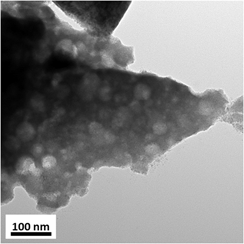Crossref Citations
This article has been cited by the following publications. This list is generated based on data provided by
Crossref.
Burakov, B.E.
and
Yagovkina, M.A.
2015.
A study of accelerated radiation damage effects in PuO2 and gadolinia-stabilized cubic zirconia, Zr0.79Gd0.14Pu0.07O1.93, doped with 238Pu.
Journal of Nuclear Materials,
Vol. 467,
Issue. ,
p.
534.
Taylor, Caitlin A.
Patel, Maulik K.
Aguiar, Jeffery A.
Zhang, Yanwen
Crespillo, Miguel L.
Wen, Juan
Xue, Haizhou
Wang, Yongqiang
and
Weber, William J.
2016.
Combined effects of radiation damage and He accumulation on bubble nucleation in Gd2Ti2O7.
Journal of Nuclear Materials,
Vol. 479,
Issue. ,
p.
542.
Wiss, T.
Freis, D.
Griveau, J.-C.
Popa, K.
Vigier, J.-F.
Somers, J.
D’Agata, E.
Konings, R.J.M.
Benes, O.
Colle, J.-Y.
Dieste, O.
and
Fernandez, A.
2017.
Investigation on the use of Americium Oxide for Space Power Sources: Radiation Damage Studies.
E3S Web of Conferences,
Vol. 16,
Issue. ,
p.
05004.
Vigier, Jean-François
Freis, Daniel
Pöml, Philipp
Prieur, Damien
Lajarge, Patrick
Gardeur, Sébastien
Guiot, Antony
Bouëxière, Daniel
and
Konings, Rudy J. M.
2018.
Optimization of Uranium-Doped Americium Oxide Synthesis for Space Application.
Inorganic Chemistry,
Vol. 57,
Issue. 8,
p.
4317.
Biasetto, L.
Corradetti, S.
Carturan, S.
Eloirdi, R.
Amador-Celdran, P.
Staicu, D.
Blanco, O. Dieste
and
Andrighetto, A.
2018.
Morphological and functional effects of graphene on the synthesis of uranium carbide for isotopes production targets.
Scientific Reports,
Vol. 8,
Issue. 1,
Dieste, O
Wiss, T
Griveau, J-C
Konings, R J M
van der Laan, G
and
Caciuffo, R
2018.
TEM-EELS analyses of protactinium.
Materials Research Express,
Vol. 6,
Issue. 2,
p.
026307.
Toth, Kalman
Buják, Renáta
Hernández, Ana Maria Sánchez
Bauwens, Jeroen
Marquez, Ramon Carlos
Buda, Razvan
Banik, Nidhu Lal
Jakopič, Rožle
Zuleger, Evelyn
and
Aregbe, Yetunde
2018.
Research on long-term stability of mixed U and Pu large-sized dried (LSD) spikes for fissile material control.
Progress in Nuclear Science and Technology,
Vol. 5,
Issue. 0,
p.
48.
Parrish, Riley J.
Liu, Xiang
Winston, Alexander
Harp, Jason M.
and
Aitkaliyeva, Assel
2019.
Radial microstructural evolution in low burnup fast reactor MOX fuel.
Journal of Nuclear Materials,
Vol. 523,
Issue. ,
p.
182.
Vălu, Sorin-Octavian
De Bona, Emanuele
Popa, Karin
Griveau, Jean-Christophe
Colineau, Eric
and
Konings, Rudy J. M.
2019.
The effect of lattice disorder on the low-temperature heat capacity of (U1−yThy)O2 and 238Pu-doped UO2.
Scientific Reports,
Vol. 9,
Issue. 1,
De Bona, E.
Benedetti, A.
Dieste, O.
Staicu, D.
Wiss, T.
and
Konings, R.J.M.
2020.
Radiation effects in alpha-doped UO2.
Nuclear Instruments and Methods in Physics Research Section B: Beam Interactions with Materials and Atoms,
Vol. 468,
Issue. ,
p.
54.
Panetier, C.
Pipon, Y.
Gaillard, C.
Moncoffre, N.
Wiss, T.
Mangin, D.
Dieste, O.
Marchand, B.
Ducher, R.
Dubourg, R.
Epicier, T.
and
Raimbault, L.
2021.
Thermal behaviour of caesium implanted in UO2: A comparative study with the xenon behaviour.
Journal of Nuclear Materials,
Vol. 543,
Issue. ,
p.
152520.
Wiss, Thierry
Dieste, Oliver
De Bona, Emanuele
Benedetti, Alessandro
Rondinella, Vincenzo
and
Konings, Rudy
2021.
SUPERFACT: A Model Fuel for Studying the Evolution of the Microstructure of Spent Nuclear Fuel during Storage/Disposal.
Materials,
Vol. 14,
Issue. 21,
p.
6538.
Corradetti, S.
Carturan, S. M.
Ballan, M.
Eloirdi, R.
Amador Celdran, P.
Walter, O.
Staicu, D.
Dieste Blanco, O.
Andrighetto, A.
and
Biasetto, L.
2021.
Effect of graphite and graphene oxide on thorium carbide microstructural and thermal properties.
Scientific Reports,
Vol. 11,
Issue. 1,
De Bona, Emanuele
Colle, Jean-Yves
Dieste, Oliver
Cologna, Marco
Wiss, Thierry
Baldinozzi, Gianguido
and
Konings, Rudy J. M.
2021.
Self-irradiation-induced disorder in (U238Pu)O2.
MRS Advances,
Wayne, David M.
Stritzinger, Jared T.
Casella, Amanda J.
Sweet, Lucas E.
Corbey, Jordan F.
Garcia, Daniel J.
Wylie, E. Miller
Tandon, Lav
Olson, Angela C.
and
Rim, Jung Ho
2021.
X‐ray diffraction, differential scanning calorimetry and evolved gas analysis of aged plutonium tetrafluoride (PuF4).
Journal of Radioanalytical and Nuclear Chemistry,
Vol. 329,
Issue. 2,
p.
741.
Griveau, Jean-Christophe
Vigier, Jean-François
Popa, Karin
Vălu, Sorin-Octavian
Colineau, Eric
and
Konings, Rudy J. M.
2022.
Low-temperature heat capacity and magnetism in (U1−yLny)O2 and (U1−yAmy)O2 (y = 0.01 − 0.05) solid solutions: Effects of substitution and self-irradiation.
Journal of Applied Physics,
Vol. 132,
Issue. 18,
Kahraman, Orhun
Lebreton, Florent
Martin, Philippe
and
Mermoux, Michel
2022.
Observable consequences of self-irradiation damage in a MIMAS-type MOX nuclear fuel as analyzed by x-ray diffraction, electron microprobe analysis, and Raman imaging. A possible methodological approach.
Journal of Applied Physics,
Vol. 132,
Issue. 11,
Lang, Eric
Beechem, Thomas
McDonald, Anthony
Friedmann, Tom
Olsson, Roy H.
Stevens, Jeffrey O.
Clark, Blythe G.
and
Hattar, Khalid
2023.
Defect structures as a function of ion irradiation and annealing in LiNbO3.
Thin Solid Films,
Vol. 768,
Issue. ,
p.
139719.
Butorin, S. M.
and
Shuh, D. K.
2023.
Electronic structure of americium sesquioxide probed by resonant inelastic x-ray scattering.
Physical Review B,
Vol. 108,
Issue. 19,
Butorin, Sergei M.
and
Shuh, David K.
2023.
Chemical bonding in americium oxides probed by X-ray spectroscopy.
Scientific Reports,
Vol. 13,
Issue. 1,





